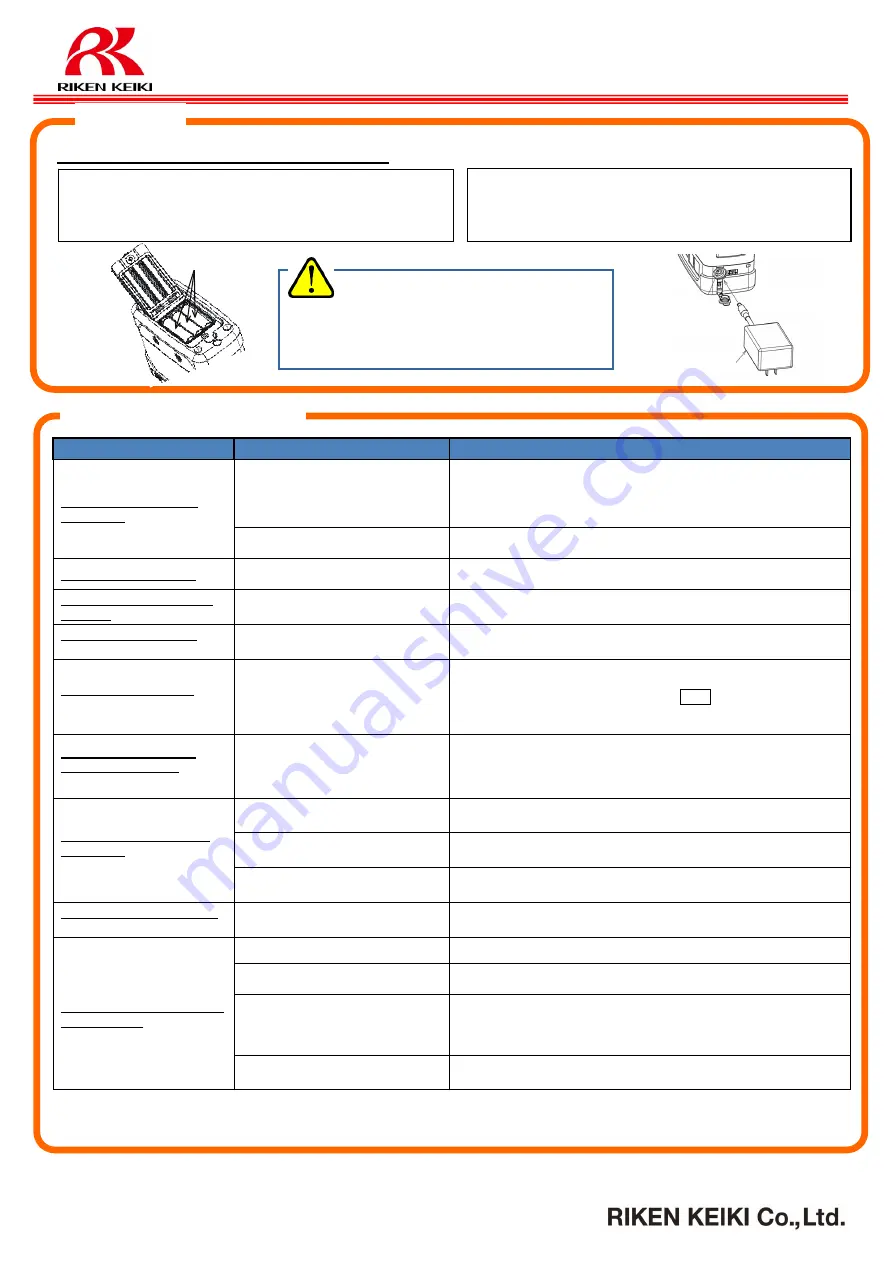
MODEL RX-8700 CONDENSED USER GUIDE
Note: Refer to the operating manual for more details.
Symptoms
Causes
Actions
The power cannot be
turned on.
The battery level is too low.
(1) Dry battery unit: Replace all the three dry batteries with
new ones in a safe place.
(2) Li-ion battery unit: Charge the battery unit in a safe place.
Improper installation of the
battery unit.
Check whether the battery unit is properly attached to the
main unit.
Abnormal operations.
Disturbances by sudden surge
noise, etc.
Turn off the power once and then turn it on again (restart).
Cannot operate the gas
monitor.
Disturbances by sudden surge
noise, etc.
Remove the battery unit in a safe place. Then reinstall it and
turn on the power to perform operations.
System abnormalities
[FAIL SYSTEM]
A main unit circuit abnormality
occurred.
Contact your sales outlet or closest RIKEN KEIKI dealer to
request repairs.
Sensor abnormalities
[FAIL SENSOR]
A sensor has failed.
Contact your sales outlet or closest RIKEN KEIKI dealer to
replace the sensor. (If [FAIL] is displayed at power-on, the
alarm can be reset by pressing the ESC button.
The unit can
continue being used for other gases using sensors other
than the failed one.)
A low battery voltage
alarm is displayed.
[FAIL BATTERY]
The battery level is low.
(1) Dry battery unit: Turn off the power and replace the dry
batteries with new ones in a safe place.
(2) Li-ion battery unit: Turn off the power and charge it in a
safe place.
A low flow rate alarm is
displayed.
[FAIL LOW FLOW]
Water, oil or the like has been
drawn in.
Check the gas sampling hose for any damage or traces of
drawn water, oil, etc.
The gas sampling hose is
clogged.
Check the gas sampling hose connections, clogging,
twisting, etc.
The pump has deteriorated.
Contact your sales outlet or closest RIKEN KEIKI dealer to
replace the pump.
Air calibration impossible
[FAIL AIR CAL]
Fresh air is not supplied around
the gas monitor.
Draw fresh air properly and perform air calibration again.
The reading rises (drops)
and remains.
Drifting of sensor output.
Perform the air calibration.
Presence of interference gas.
Check if any interference gas such as solvent is present, and
take measures properly.
Slow leak.
A very small amount of the gas to be measured may be
leaking (slow leak). Ignoring this may result in a dangerous
situation, so take the same actions and measures as those
when a gas alarm occurs.
Environmental changes.
Perform the air calibration. In particular, the oxygen sensor is
affected by the air pressure.
This troubleshooting chart is to be used as a simple guide for identifying the causes of common malfunctions.
Contact your sales outlet or closest RIKEN KEIKI dealer if your gas monitor is experiencing symptoms not listed
here, or if symptoms remain unresolved even after taking these actions.
Make sure to inspect your gas monitor once a year or more frequently,
to ensure that performance is maintained.
Troubleshooting
6. Replacing/charging the battery
[Li-ion battery unit]
Insert the AC adapter plug into the charging jack
on the side of the battery unit to charge the
battery.
Dry batteries
[Dry battery unit]
Use a flathead screwdriver or similar tool to open
the battery cover on the bottom of the main unit,
and replace the three dry batteries with new ones.
Usage
Danger
Replace the dry battery unit and dry
batteries, or charge the Li-ion battery unit
in a safe place.
Charging
jack
AC adapter
Plug
















